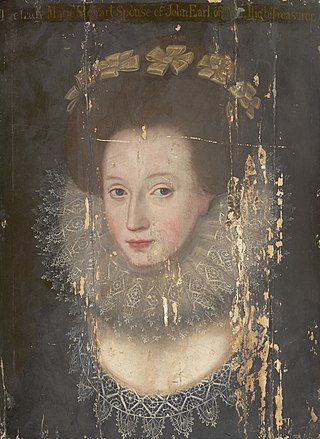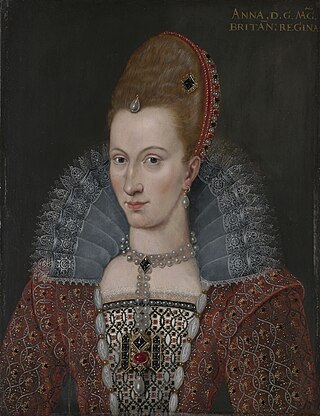John Stewart, 4th Earl of Atholl, called the Fair, was a Scottish nobleman and courtier. He was favoured by Mary, Queen of Scots, but later turned against her.

John Erskine, 1st Earl of Mar was a Scottish aristocrat and politician. He was the custodian of the infant James VI of Scotland and Regent of Scotland.

John Erskine, 2nd Earl of Mar was a Scottish politician, the only son of another John Erskine and Annabella Murray. He is regarded as both the 19th earl and the 2nd earl.

George Home, 1st Earl of Dunbar, KG, PC was, in the last decade of his life, the most prominent and most influential Scotsman in England. His work lay in the King's Household and in the control of the State Affairs of Scotland and he was the King's chief Scottish advisor. With the full backing and trust of King James he travelled regularly from London to Edinburgh via Berwick-upon-Tweed.

John Maitland, 1st Lord Maitland of Thirlestane, of Lethington, Knight (1581), was Lord Chancellor of Scotland.

Seton Palace was situated in East Lothian, a few miles south-east of Edinburgh near the town of Prestonpans. Often regarded as the most desirable Scottish residence of the sixteenth and seventeenth centuries, the palace was erected in the 15th century by George, 4th Lord Seton.
Sir John Carmichael was a Scottish soldier, the Keeper of Liddesdale, a diplomat, and owner of Fenton Tower at Kingston, East Lothian.

Mar's Wark is a ruined building in Stirling built 1570–1572 by John Erskine, Regent of Scotland and Earl of Mar, and now in the care of Historic Scotland. Mar intended the building for the principal residence of the Erskine family in Stirling, whose chief had become hereditary keeper of the nearby royal Stirling Castle where the princes of Scotland were schooled. Wark is a Scots language word for work, and here it means building. The house is also called "Mar's Lodging."

Marie Stewart, Countess of Mar (1576-1644) was a Scottish courtier. She was the daughter of Esmé Stewart, 1st Duke of Lennox and Catherine de Balsac d’Entragues (d. c.1631) and a favourite of James VI of Scotland. After her marriage, as was customary in Scotland, she did not change her name, and signed her letters as "Marie Stewart".
Annabell Murray, Countess of Mar (1536–1603), was a Scottish landowner, courtier and royal servant, the keeper of the infant James VI and his son Prince Henry at Stirling Castle
George Young was a Scottish churchman, courtier, member of the Privy Council of Scotland, diplomat, and secretary depute.

On 17 May 1590, Anne of Denmark was crowned Queen of Scotland. There was also a ceremony of joyous entry into Edinburgh on 19 May, an opportunity for spectacle and theatre and allegorical tableaux promoting civic and national identities, similar in many respects to those performed in many other European towns. Celebrations for the arrival of Anne of Denmark in Scotland had been planned and prepared for September 1589, when it was expected she would sail from Denmark with the admirals Peder Munk and Henrik Gyldenstierne. She was delayed by accidents and poor weather and James VI of Scotland joined her in Norway in November. They returned to Scotland in May 1590.
Sir William Keith of Delny was a Scottish courtier and Master of the Royal Wardrobe. He also served as ambassador for James VI to various countries. He was an important intermediary between George Keith, 5th Earl Marischal and the king, the king and courtiers, and the king and foreign governments.
William Murray of Tullibardine was a Scottish courtier and leader of the Clan Murray.
Margaret Livingstone, Countess of Orkney was a Scottish courtier and landowner. She was a daughter of William Livingstone, 6th Lord Livingston and Agnes Fleming.
Margaret Fleming, Countess of Atholl (1536-1586) was a Scottish courtier and landowner rumoured to be involved in the occult. She served as lady-in-waiting to Mary, Queen of Scots.

Magdalen Livingstone was a Scottish courtier. She was a favoured lady-in-waiting to Mary, Queen of Scots, and later belonged to the household of Prince Henry.
Tullibardine Castle was a castle located in the village of Tullibardine, 2 miles (3.2 km) north of Auchterarder in Perth and Kinross, Scotland.
William Stewart of Caverston and Traquair, was a Scottish landowner and Captain of Dumbarton Castle.

Anne of Denmark (1574–1619) was the wife of King James VI and I, and as such Queen of Scotland from their marriage by proxy on 20 August 1589 and Queen of England and Ireland from 24 March 1603 until her death in 1619. When Anne intended to sail to Scotland in 1589 her ship was delayed by adverse weather. Contemporary superstition blamed the delays to her voyage and other misfortunes on "contrary winds" summoned by witchcraft. There were witchcraft trials in Denmark and in Scotland. The King's kinsman, Francis Stewart, 5th Earl of Bothwell came into suspicion. The Chancellor of Scotland John Maitland of Thirlestane, thought to be Bothwell's enemy, was lampooned in a poem Rob Stene's Dream, and Anne of Denmark made Maitland her enemy. Historians continue to investigate these events.











